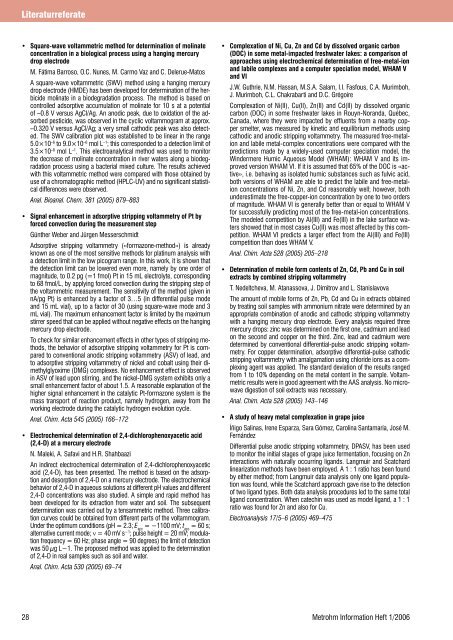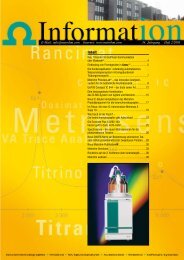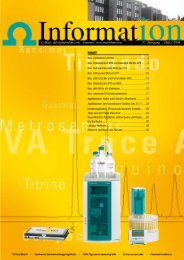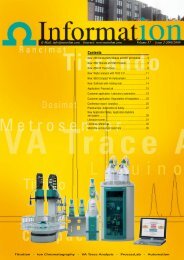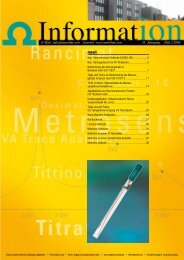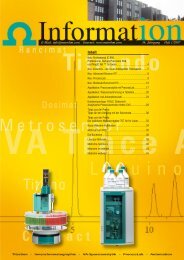World Champion in der Elektroanalytik - Metrohm AG
World Champion in der Elektroanalytik - Metrohm AG
World Champion in der Elektroanalytik - Metrohm AG
Sie wollen auch ein ePaper? Erhöhen Sie die Reichweite Ihrer Titel.
YUMPU macht aus Druck-PDFs automatisch weboptimierte ePaper, die Google liebt.
Literaturreferate<br />
• Square-wave voltammetric method for determ<strong>in</strong>ation of mol<strong>in</strong>ate<br />
concentration <strong>in</strong> a biological process us<strong>in</strong>g a hang<strong>in</strong>g mercury<br />
drop electrode<br />
M. Fátima Barroso, O.C. Nunes, M. Carmo Vaz and C. Delerue-Matos<br />
A square-wave voltammetric (SWV) method us<strong>in</strong>g a hang<strong>in</strong>g mercury<br />
drop electrode (HMDE) has been developed for determ<strong>in</strong>ation of the herbicide<br />
mol<strong>in</strong>ate <strong>in</strong> a biodegradation process. The method is based on<br />
controlled adsorptive accumulation of mol<strong>in</strong>ate for 10 s at a potential<br />
of –0.8 V versus AgCl/Ag. An anodic peak, due to oxidation of the adsorbed<br />
pesticide, was observed <strong>in</strong> the cyclic voltammogram at approx.<br />
–0.320 V versus AgCl/Ag; a very small cathodic peak was also detected.<br />
The SWV calibration plot was established to be l<strong>in</strong>ear <strong>in</strong> the range<br />
5.0×10 –6 to 9.0×10 –6 mol L –1 ; this corresponded to a detection limit of<br />
3.5×10 –8 mol L –1 . This electroanalytical method was used to monitor<br />
the decrease of mol<strong>in</strong>ate concentration <strong>in</strong> river waters along a biodegradation<br />
process us<strong>in</strong>g a bacterial mixed culture. The results achieved<br />
with this voltammetric method were compared with those obta<strong>in</strong>ed by<br />
use of a chromatographic method (HPLC-UV) and no significant statistical<br />
differences were observed.<br />
Anal. Bioanal. Chem. 381 (2005) 879–883<br />
• Signal enhancement <strong>in</strong> adsorptive stripp<strong>in</strong>g voltammetry of Pt by<br />
forced convection dur<strong>in</strong>g the measurement step<br />
Günther Weber and Jürgen Messerschmidt<br />
Adsorptive stripp<strong>in</strong>g voltammetry («formazone-method») is already<br />
known as one of the most sensitive methods for plat<strong>in</strong>um analysis with<br />
a detection limit <strong>in</strong> the low picogram range. In this work, it is shown that<br />
the detection limit can be lowered even more, namely by one or<strong>der</strong> of<br />
magnitude, to 0.2 pg (=1 fmol) Pt <strong>in</strong> 15 mL electrolyte, correspond<strong>in</strong>g<br />
to 68 fmol/L, by apply<strong>in</strong>g forced convection dur<strong>in</strong>g the stripp<strong>in</strong>g step of<br />
the voltammetric measurement. The sensitivity of the method (given <strong>in</strong><br />
nA/pg Pt) is enhanced by a factor of 3…5 (<strong>in</strong> differential pulse mode<br />
and 15 mL vial), up to a factor of 30 (us<strong>in</strong>g square-wave mode and 3<br />
mL vial). The maximum enhancement factor is limited by the maximum<br />
stirrer speed that can be applied without negative effects on the hang<strong>in</strong>g<br />
mercury drop electrode.<br />
To check for similar enhancement effects <strong>in</strong> other types of stripp<strong>in</strong>g methods,<br />
the behavior of adsorptive stripp<strong>in</strong>g voltammetry for Pt is compared<br />
to conventional anodic stripp<strong>in</strong>g voltammetry (ASV) of lead, and<br />
to adsorptive stripp<strong>in</strong>g voltammetry of nickel and cobalt us<strong>in</strong>g their dimethylglyoxime<br />
(DMG) complexes. No enhancement effect is observed<br />
<strong>in</strong> ASV of lead upon stirr<strong>in</strong>g, and the nickel-DMG system exhibits only a<br />
small enhancement factor of about 1.5. A reasonable explanation of the<br />
higher signal enhancement <strong>in</strong> the catalytic Pt-formazone system is the<br />
mass transport of reaction product, namely hydrogen, away from the<br />
work<strong>in</strong>g electrode dur<strong>in</strong>g the catalytic hydrogen evolution cycle.<br />
Anal. Chim. Acta 545 (2005) 166–172<br />
• Electrochemical determ<strong>in</strong>ation of 2,4-dichlorophenoxyacetic acid<br />
(2,4-D) at a mercury electrode<br />
N. Maleki, A. Safavi and H.R. Shahbaazi<br />
An <strong>in</strong>direct electrochemical determ<strong>in</strong>ation of 2,4-dichlorophenoxyacetic<br />
acid (2,4-D), has been presented. The method is based on the adsorption<br />
and desorption of 2,4-D on a mercury electrode. The electrochemical<br />
behavior of 2,4-D <strong>in</strong> aqueous solutions at different pH values and different<br />
2,4-D concentrations was also studied. A simple and rapid method has<br />
been developed for its extraction from water and soil. The subsequent<br />
determ<strong>in</strong>ation was carried out by a tensammetric method. Three calibration<br />
curves could be obta<strong>in</strong>ed from different parts of the voltammogram.<br />
Un<strong>der</strong> the optimum conditions (pH = 2.3; E acc = −1100 mV; t acc = 60 s;<br />
alternative current mode; n = 40 mV s −1 ; pulse height = 20 mV; modulation<br />
frequency = 60 Hz; phase angle = 90 degrees) the limit of detection<br />
was 50 μg L−1. The proposed method was applied to the determ<strong>in</strong>ation<br />
of 2,4-D <strong>in</strong> real samples such as soil and water.<br />
Anal. Chim. Acta 530 (2005) 69–74<br />
• Complexation of Ni, Cu, Zn and Cd by dissolved organic carbon<br />
(DOC) <strong>in</strong> some metal-impacted freshwater lakes: a comparison of<br />
approaches us<strong>in</strong>g electrochemical determ<strong>in</strong>ation of free-metal-ion<br />
and labile complexes and a computer speciation model, WHAM V<br />
and VI<br />
J.W. Guthrie, N.M. Hassan, M.S.A. Salam, I.I. Fasfous, C.A. Murimboh,<br />
J. Murimboh, C.L. Chakrabarti and D.C. Grégoire<br />
Complexation of Ni(II), Cu(II), Zn(II) and Cd(II) by dissolved organic<br />
carbon (DOC) <strong>in</strong> some freshwater lakes <strong>in</strong> Rouyn-Noranda, Québec,<br />
Canada, where they were impacted by effluents from a nearby copper<br />
smelter, was measured by k<strong>in</strong>etic and equilibrium methods us<strong>in</strong>g<br />
cathodic and anodic stripp<strong>in</strong>g voltammetry. The measured free-metalion<br />
and labile metal-complex concentrations were compared with the<br />
predictions made by a widely-used computer speciation model, the<br />
W<strong>in</strong><strong>der</strong>mere Humic Aqueous Model (WHAM): WHAM V and its improved<br />
version WHAM VI. If it is assumed that 65% of the DOC is «active»,<br />
i.e. behav<strong>in</strong>g as isolated humic substances such as fulvic acid,<br />
both versions of WHAM are able to predict the labile and free-metalion<br />
concentrations of Ni, Zn, and Cd reasonably well; however, both<br />
un<strong>der</strong>estimate the free-copper-ion concentration by one to two or<strong>der</strong>s<br />
of magnitude. WHAM VI is generally better than or equal to WHAM V<br />
for successfully predict<strong>in</strong>g most of the free-metal-ion concentrations.<br />
The modeled competition by Al(III) and Fe(III) <strong>in</strong> the lake surface waters<br />
showed that <strong>in</strong> most cases Cu(II) was most affected by this competition.<br />
WHAM VI predicts a larger effect from the Al(III) and Fe(III)<br />
competition than does WHAM V.<br />
Anal. Chim. Acta 528 (2005) 205–218<br />
• Determ<strong>in</strong>ation of mobile form contents of Zn, Cd, Pb and Cu <strong>in</strong> soil<br />
extracts by comb<strong>in</strong>ed stripp<strong>in</strong>g voltammetry<br />
T. Nedeltcheva, M. Atanassova, J. Dimitrov and L. Stanislavova<br />
The amount of mobile forms of Zn, Pb, Cd and Cu <strong>in</strong> extracts obta<strong>in</strong>ed<br />
by treat<strong>in</strong>g soil samples with ammonium nitrate were determ<strong>in</strong>ed by an<br />
appropriate comb<strong>in</strong>ation of anodic and cathodic stripp<strong>in</strong>g voltammetry<br />
with a hang<strong>in</strong>g mercury drop electrode. Every analysis required three<br />
mercury drops: z<strong>in</strong>c was determ<strong>in</strong>ed on the first one, cadmium and lead<br />
on the second and copper on the third. Z<strong>in</strong>c, lead and cadmium were<br />
determ<strong>in</strong>ed by conventional differential-pulse anodic stripp<strong>in</strong>g voltammetry.<br />
For copper determ<strong>in</strong>ation, adsorptive differential-pulse cathodic<br />
stripp<strong>in</strong>g voltammetry with amalgamation us<strong>in</strong>g chloride ions as a complex<strong>in</strong>g<br />
agent was applied. The standard deviation of the results ranged<br />
from 1 to 10% depend<strong>in</strong>g on the metal content <strong>in</strong> the sample. Voltammetric<br />
results were <strong>in</strong> good agreement with the AAS analysis. No microwave<br />
digestion of soil extracts was necessary.<br />
Anal. Chim. Acta 528 (2005) 143–146<br />
• A study of heavy metal complexation <strong>in</strong> grape juice<br />
Íñigo Sal<strong>in</strong>as, Irene Esparza, Sara Gómez, Carol<strong>in</strong>a Santamaría, José M.<br />
Fernández<br />
Differential pulse anodic stripp<strong>in</strong>g voltammetry, DPASV, has been used<br />
to monitor the <strong>in</strong>itial stages of grape juice fermentation, focus<strong>in</strong>g on Zn<br />
<strong>in</strong>teractions with naturally occurr<strong>in</strong>g ligands. Langmuir and Scatchard<br />
l<strong>in</strong>earization methods have been employed. A 1 : 1 ratio has been found<br />
by either method; from Langmuir data analysis only one ligand population<br />
was found, while the Scatchard approach gave rise to the detection<br />
of two ligand types. Both data analysis procedures led to the same total<br />
ligand concentration. When catech<strong>in</strong> was used as model ligand, a 1 : 1<br />
ratio was found for Zn and also for Cu.<br />
Electroanalysis 17/5–6 (2005) 469–475<br />
28 <strong>Metrohm</strong> Information Heft 1/2006


